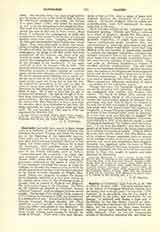

Camisards (probably from camise, a black blouse worn as a uniform), a. sect of French fanatics who terrorized Dauphine, Vivarais, and chiefly the Cevennes in the beginning of the eighteenth century. Their origin was due to various causes: the Albigensian spirit which had not completely died out in that region, and which caused Pope Clement XI to style the Camisards “that execrable race of ancient Albigenses“; the apocalyptic preaching and literature of the French Calvinists, such as Jurieu’s “Accomplissement des propheties”, on which they were nourished; and the revocation of the Edict of Nantes (1685), along with the singular methods of conversion employed by the agents of Louis XIV. If the Camisards withstood the armies of Louis for wellnigh two decades, the reason is to be found in the desultory manner of warfare which the latter adopted, in the failure of Louis’ generals, de Broglie, Montrevel, Villars, etc., properly to realize the danger of the situation, and also, to a very great extent, in the support given them by the Protestant house of Nassau, then in control of Holland and England. The insurrection began in the Cevennes. Du Serre, an old Calvinist of Dieulefit in Dauphine, became suddenly “inspired”, and his religious hysteria spread rapidly. The murder of the Abbe de Chaila, inspector of the missions in Cevennes, in 1702, was tantamount to a declaration of war. Armed bands led by Seguier, Laporte, Castanet, Ravenel, Cavalier, and others carried on a sort of guerilla warfare till about 1705, when they either surrendered or were destroyed. In 1709 Cavalier, who had sought refuge in England, tried, though without much success, to rekindle the revolt in Vivarais. There were a few more disturbances as late as 1711, when a treaty of peace with England deprived the Camisards of a powerful support. On the 8th of March, 1715, by medals and a proclamation, Louis XIV announced the entire extinction of the sect.
Much has been written on the “prophets” of the Camisard uprising. Flechier and Brueys believed in a school of prophets, wherein Du Serre gave a systematic training, chiefly to young recruits. The prophetic inspiration, of which there were four degrees, avertissement, souffle, propheties, dons, was communicated by breathing upon subjects who had gone through severe macerations, memorized long Biblical texts and formulae of imprecation, learned to perform the strangest contortions, and generally wrought themselves into a sort of trance. On the other hand, Court and Arnauld, themselves Calvinists, deny the very existence of such a school. They cast aside as obviously fraudulent a number of so-called spiritual manifestations. The rest they trace to an overheated imagination, pietism, excessive fasts, the reading of the Prophets and Jurieu’s pastoral letters, and also to the peculiar temperament of those Southern mountaineers. If such is the case, there is no need of admitting with Gorres, Mirville, and H. Blanc supernatural influences—diabolical, of course—to account for the Camisards’ antics.
Though Calvinists, the Camisards should not be too closely identified with Calvinism. Many Calvinists condemned their cruelties and despised their visions. The Synod of Nimes, 1715, enacted two statutes, evidently aimed at the Camisards: that women and unauthorized persons be debarred from preaching; and that Holy Scripture be adopted as the sole rule of faith and source of preaching. Fourteen years after that synod Court had organized in Languedoc a strong Calvinist community, in which no traces of the Camisard spirit could be discerned. It is true that those who had fled to England did try to propagate their “mystical phalanx” in London, and published in 1707, in the British capital, a mass of Camisard literature: “Le theatre sacre des Cevennes”; “A cry from the desert”; etc.; but the Consistory of the French Church in the Savoy pronounced their ecstasies to be assumed habits. Voltaire (Siecle de Louis XIV, xxxvi) relates that Elie Marion, one of the refugees, became unpopular, both on account of his writings (avertissements prophetiques) and false miracles, and was at last compelled to leave England. Catholics, too, organized under the name of White Camisards, or Cadets of the Cross, the better to check the black Camisards, but they soon fell into atrocities similar to those they sought to punish, and were disowned by Montrevel.
J. F. SOLLIER

